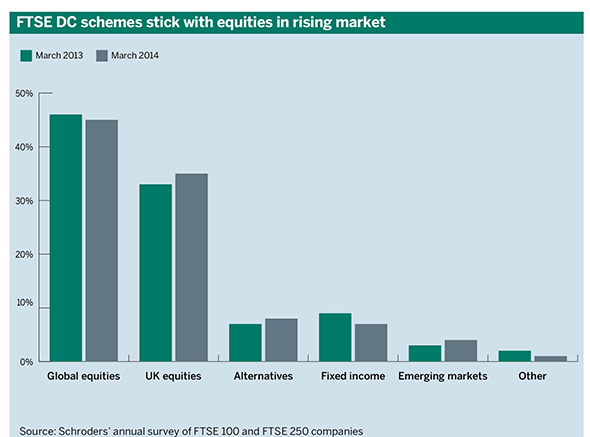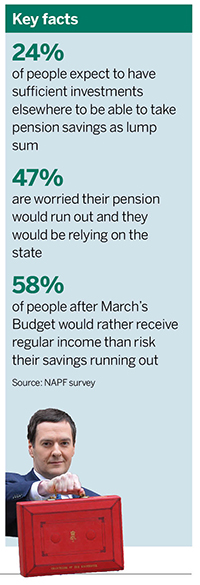This quarter's DC debate focuses on the investment options that will suit savers in the post-Budget world, including the ever-present battle of jargon and whether members will understand the newfound flexibilities.

With equity markets at or near historic highs, isn’t a traditional high equity low-cost DC strategy proving its merits?
Richard Butcher: Yes it is, but that ignores the active management argument. Markets at a high are likely to go down at some point. A passive manager will suffer from that. What represents good value is the asset that will produce long-term growth consistent with the desired risk characteristics. There is no generic right answer to this. What is good value will depend on the needs of the population of members in the scheme.
Andy Cheseldine: Equity markets have performed well over the past few years, and long-term portfolios should clearly be weighted towards growth assets. However, the current DC investor now includes everyone from 22-year-old auto-enrolees, who can typically afford to be fully invested in equities, to retirees past their normal pension date who have entered drawdown but are still expecting to buy an annuity in due course. Good value is a function of current asset class perceived value, value-at-risk, targeted long-term growth, liquidity and accessibility.
Helen Roberts: Equity and bond markets have been doing well in recent months, both driven by quantitative easing and a belief that interest rates will remain low for many years. One could argue that investors are being too complacent. Pension funds need to ensure they have a good diversified mix of assets to weather the storm of interest rate changes and other surprises in order to meet their members’ needs. A number of schemes are considering property and infrastructure as a way to add yield, diversification and a steady income flow.
Tim Banks: Yes, in the current environment traditional strategies have done well. But how do you provide for members when equity markets are not moving forward? We have seen that the greatest scrutiny of investment default strategies is when things aren’t going well. We must provide for uncertainty when designing default investment strategies.
Clearly there is no such thing as passive asset allocation, this needs to be actively managed. This can be achieved within a portfolio-managed target date fund, but is difficult to achieve in a formulaic lifestyle. It is our belief that both strategic and tactical asset allocation should be proactively managed on a daily basis, using professional portfolio manager oversight. This is what members would expect.

Martin Thompson: Schemes and investors that resisted the urge to diversify have done well of late. Fundamentally, investing in growth assets has always provided a good hedge against inflation and as long as members are educated about pound cost averaging and that volatility is only really something to worry about in the years running up to retirement, there is nothing wrong with the traditional approach. It really depends on what they are looking to achieve – growth, capital protection, an annuity hedge or income generation. Most DC members will have one of these objectives, so value means different things to different members.
Andrew Dickson: Record-low interest rates have forced investors further up the risk spectrum to find returns. This has left many asset valuations stretched and vulnerable to market shocks, particularly given the prevailing geopolitical and economic uncertainty.
It is at just such times active management can add greatest value. For example, through rigorous fundamental analysis, we can identify assets likely to benefit in otherwise adverse market conditions, with the aim of building a diversified portfolio resilient to multiple market stresses. And remember, DC members are investing monthly so are buying equities at peak valuations, which presents market timing
Steven Charlton: Buying into equities or any asset class after a strong period of performance has seldom been a good strategy. However, building default funds that recognise the different levels of risk that members should be able to live with, at different points during their journey to retirement, will be right for trustees and employers. Then, having implemented the right asset allocation through low-cost funds, members are usually best served by ignoring short-term market noise and resisting the temptation.
Nigel Aston: Effective risk management is about surviving the bad times while prospering in the good. It is important for trustees not to be tempted by favourable market conditions into underdiversified strategies, particularly where the asset allocation is static, rather than dynamic. We’ve been there before, with some schemes and their members still bearing the scars. All of our research points to members disliking the volatility of pure equity strategies. We also firmly believe that avoiding profound market corrections also delivers better long-term performance.
Will the backlash against active management extend into DC? What value can active management add, and is it worth the cost?
Thompson: To a degree it already has, with many schemes choosing passive defaults over active management as it removes manager risk. It’s also easier to explain to members that the reason a fund has gone down is due to the market, rather than the manager making poor decisions.
The secret sauce is derived from a blend of active and passive capabilities
Nigel Aston, SSGA
Aston: Asset allocation is the major driver of returns and is an area where there can be value in an active approach. Risk is not always rewarded and it pays to change the asset mix to reflect market conditions. In other words, the trick is to be in the right assets at the right time. The secret sauce is derived from a blend of active and passive capabilities.
Dickson: Cost is pivotal in DC provision, but is not a goal in itself. The challenge for the pensions industry is to deliver good member outcomes within a cost-constrained environment. Active management attracted bad press during the financial crisis, when it became apparent traditional efforts to diversify were often no better than passive strategies. However, there is growing recognition that innovative multi-asset approaches can be highly effective.
Charlton: The real backlash is against high-cost investing. Investors increasingly understand that the concept of ‘reassuringly expensive’ doesn’t apply in the world of investment. So the backlash is against high-cost rather than active and it is just as important to minimise cost in DC as anywhere else.
Butcher: The charge cap is creating momentum towards passive management. As for what value active management can add – this is the age-old question and the answer is the same now: active management can take a tactical view of where to add or protect value.
Roberts: The price cap is focusing attention on the lower cost of passive management, but it is important schemes continue to consider active strategies where trustees believe they add sufficient value to justify cost.
Cheseldine: Bearing in mind the 0.75 per cent a year charge cap for auto-enrolment default funds, it is difficult to see how purely active portfolios can be used in the future. But if you accept that active asset allocation can reduce risk and add value, there should be a place for diversified growth funds as part of a balanced portfolio.
Banks: DC investment strategies are already built to a cost, with the price cap applying to AE schemes from next April. Flexible target date funds can accommodate active or passive components, which can be changed easily at any time. This gives clients freedom to reflect their investment beliefs.
Since last quarter’s debate, we have seen detail on flexi-access drawdown and uncrystallised funds pension lump sums. Which retirement options will prove popular with members?
Butcher: In the immediate future: cash. The average pot at retirement is still lower than £30k and this will come down in the short term as a result of AE. In the longer term, I’d have thought the UFPLS would be more popular, as it allows the tax-free element to grow in absolute terms.
Thompson: Both options will be attractive, but it will be important to make members aware of the consequences, including the reduction in the annual allowance to £10,000. We believe the UFPLS was introduced primarily so members can access funds without schemes having to offer drawdown.
 Banks: We have just launched a low-cost income drawdown product designed to be used as a default income option for individuals with pot sizes starting at £20,000. This is available to trust-based schemes, and is essentially an income-paying target date fund. We expect similar levels of innovation in the contract-based space in the near future.
Banks: We have just launched a low-cost income drawdown product designed to be used as a default income option for individuals with pot sizes starting at £20,000. This is available to trust-based schemes, and is essentially an income-paying target date fund. We expect similar levels of innovation in the contract-based space in the near future.
Aston: We believe members will value the ability to receive a regular flow of predictable and sustainable income, while knowing they can get access to more of their capital if the need arises. Some will want a tax-free lump sum upfront, while others will be happy to draw down and get 25 per cent tax-free. The challenge for the industry is to make these mechanisms intuitive and user-friendly.
Cheseldine: All of them. Most DC pots taken at retirement over the next five years are likely to be small – less than £10,000 – because there will be lots of auto-enrolled members reaching retirement age after only two or three years of saving. Most of these individuals will be able to take their UFPLS without adverse tax consequences and will do so. When minimum contributions reach 8 per cent of qualifying earnings, both drawdown and annuity purchase will become more common.
Roberts: It is important to remember it is still possible for people to take an annuity. NAPF research found most people (58 per cent) would rather receive a regular income for life than risk their pension savings running out. Drawdown looks a more flexible option for people who want to keep their money invested and take an income. However, it could be that people want to draw down on their pension using the UFPLS, meaning they don’t have to move the rest of their pot out of their pension and decide on a particular drawdown product.
Dickson: It’s impossible to predict, but a key determinant will be an individual’s tax position. Experience elsewhere suggests most DC members will remain invested and select some form of drawdown. However, some may still prefer annuities and others will opt for cash.
Charlton: While the public and industry has given the thumbs up to the new flexibilities, I doubt many members will have given thought to which option might be best for them, unless they are within a few months of retirement. By extension I think it is hard to predict which options might prove popular until we see the decisions that members will take from the options that develop for them – of course, the allure of cash will always have its place.
It is important to remember it is still possible for people to take an annuity. NAPF research found most people (58 per cent) would rather receive a regular income for life than risk their pension savings running out. Drawdown looks a more flexible option for people who want to keep their money invested and take an income. However, it could be that people want to draw down on their pension using the UFPLS, meaning they don’t have to move the rest of their pot out of their pension and decide on a particular drawdown product.
Dickson: It’s impossible to predict, but a key determinant will be an individual’s tax position. Experience elsewhere suggests most DC members will remain invested and select some form of drawdown. However, some may still prefer annuities and others will opt for cash.
Charlton: While the public and industry has given the thumbs up to the new flexibilities, I doubt many members will have given thought to which option might be best for them, unless they are within a few months of retirement. By extension I think it is hard to predict which options might prove popular until we see the decisions that members will take from the options that develop for them – of course, the allure of cash will always have its place.
Jargon is an ever-present challenge. How can the industry start to explain UFPLS and other DC options in a clearer way?
Aston: Hopefully, members never see or hear the terms FADF and UFPLS. If we focus on what it means for the member – tax-free cash now and taxable withdrawals in future or a tax-free element to each payment – then there should be less confusion.
Roberts: Concepts such as crystallisation will not be easy to convey. We would encourage the Treasury and the guidance providers to develop simple ways of communicating complex options for members. Schemes can also help members by using their expertise to highlight good-value options.
Thompson: Nest did a great job a few years ago of demystifying pensions, but the government seems determined to introduce new jargon whenever it makes a legislative change. However, the concepts behind flexi-access drawdown and UFPLS are not complicated, so perhaps the Plain English Campaign could be engaged by the industry to produce a jargon-buster that could be used by all providers and schemes.
Charlton: Jargon is the enemy of investor engagement. If you keep the client at the heart of what you do and remember to speak about benefits rather than features, it’s easy to explain the concepts of investing in straightforward and engaging language. Too many providers focus on their own expertise rather than stopping to apply the ‘so what’ test.
Cheseldine: Nest and others have made a good stab at reducing jargon and we need to keep pushing that. The member does not really care whether it is a trivial, small or winding-up lump sum, so I expect in communications we will revert to ‘tax-free lump sum’ and introduce ‘taxable lump sum’ for UFPLS.
Banks: Jargon is an ever-present challenge for consumers. Our job is to make the information simple and easy to access. Ultimately it is about providing the right information, at the right time for savers, in the way in which they wish to be communicated to.
Dickson: The guidance DC investors receive at the point of taking benefits will be key. With the new pension freedoms comes greater complexity. Therefore, there is greater onus than ever on pension professionals to promote clear understanding and instil member confidence.
Butcher: The real problem is an inability to make informed decisions. We need to communicate, engage and educate and this process needs to begin before people even join a pension scheme. If we have better educated consumers, they will make better consumption decisions.






